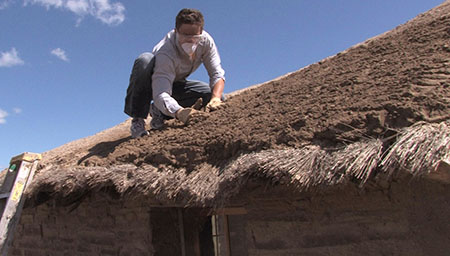Improving the Roof

Applying the Final Render Coating to the Roof
The original roofs on the Hutmacher farmstead were made of branches, straw and a layer of clay. Heavy rain would wash clay off the roof and the clay needed to be replaced to prevent the roof from leaking.
This regular maintenance was not a difficulty when the family occupied the site. Keeping an eye on the roofs and adding clay when necessary was just a regular part of the farm chores.
The need to continue this level of yearly maintenance for a historic site eventually led to the deterioration of the site. The Dunn County Historic Society was unable to supply the necessary manpower or time to keep the property up.
Architectural consultant Edward Crocker was tasked with improving the design of the earthen roof to lengthen the maintenance cycle.
The first recommended change was to use flax straw instead of the original wheat straw. Flax Straw was stiffer than wheat straw and made placing of the base layer of clay easier.
As with the original roof, the first layer on the straw was pure clay, intended to create a waterproof barrier to the thatch.
On top of the clay layer is a mixture of clay, lime and angular aggregate, intended to absorb moisture when the roof is wet and release moisture during dry conditions. Lime acts as binder and angular aggregate strengthens the material to keep it from being washed.
The final layer is much like the exterior render coating on the walls. It is a mixture of clay, lime, aggregate and short pieces of straw. Its purpose is to break up the flow of water, allowing the water to sheet off the roof. This sacrificial layer is intended to prevent formation of gullies in the roofs.
Improving the Roof

